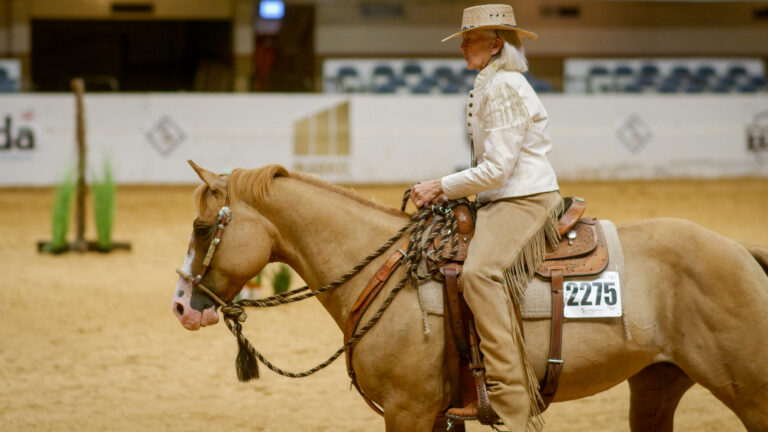There are a few things you definitely don’t want when your horse backs. The first thing that turns me off about a horse’s backup is intimidation—the horse looks scared and “overdone,” with his nose tucked back to his chest and a fearful expression. A hollow back that doesn’t engage his whole body isn’t pleasing to the eye, and neither is a horse that gets hung up or draggy as he backs. If you take your time training your horse to back as I demonstrate here, you won’t have to worry about any of those problems.

One
I’m backing my horse here to demonstrate a few different problems. First, his head and neck are elevated and his nose is out, which means he can’t round his back and engage his hindquarters to collect his body. This body position predisposes him to “getting stuck.” That is, he can’t move his feet backward as easily as I’d like. (Though I don’t want him to rush backward faster than he’s capable, either.) Stiffness in my body, especially my wrists and hands, echoes the stiffness in my horse’s body.
Two
My horse’s head and neck are in a better position here, but you can tell that my body is tipped slightly forward. This is a problem I see with many amateur riders—they get tense and bunched up, which tips them forward. This extra weight on my horse’s front end means he can’t easily and smoothly move his front end backward. He’ll have to work harder to maintain a steady, even pace for a smooth backup.

Three
Now we’re getting somewhere. My hands are low, but not below my saddle horn, to have a steady, low pull to cue my horse’s front end. As a result, he flexes at his poll to give to the bit’s pressure and flexes his neck. My seat and feet play a vital role here. I’m sitting back on my pockets—not leaning forward—and my feet are slightly in front of my hips. I apply pressure with my heels on my horse’s belly, alternating left and right, to urge him backward. Once he’s comfortable with this cue to back, I can increase the rhythm of my feet bumping his sides to encourage him to move his feet backward faster.
Four
If my horse gets stuck—that is, he’s not responding to my backup cues—I can use my hands to “unstick” his front feet. By placing more pressure on either my left or right rein (only one side at a time), I can move my horse’s shoulders in that direction to get him moving again. Here I use a stronger cue from my right hand to pull my horse’s shoulders to the right. My left hand is in a supporting position to push his front end to the right. When he moves one step to the right, I’ll use the same cue switched to move to the left. We rock back and forth until he’s “unstuck.” Then I can straighten him out and continue moving backward.

Five
Similarly, I can use my legs to move my horse’s hindquarters to get him going if he’s stuck. Here, I use pressure from my right leg, placed behind the cinch, to push my horse’s hips to the left, toward the camera. I’ll rock him back to the right by using my left leg in a similar fashion. Then we’ll straighten out and continue backward.
Six
The release is key when working on backing, just as with any other training maneuver. After backing up a few steps, I release all pressure from my hands and legs and let my horse relax. You can see my hands are lowered onto my horse’s neck to release bit pressure and my feet and legs are off his sides. This lets him know he’s done backing up and can stand. If you ride a reining horse and add speed to your backup or show in horsemanship, the release that cues him to stop and stand still is essential.
Crystal McNutt, trains reining horses and coaches amateur riders in Scottsdale, Arizona. She’s had especially notable success showing Arabians and Half-Arabians in NRHA and Arabian Horse Association events, but she also shows stock breeds. In 2011, she was inducted into the Arabian Professional and Amateur Horseman’s Association Working Western Trainer Hall of Fame and named the Horsewoman of the Year for that group. Learn more at crystalmcnutt.com.






